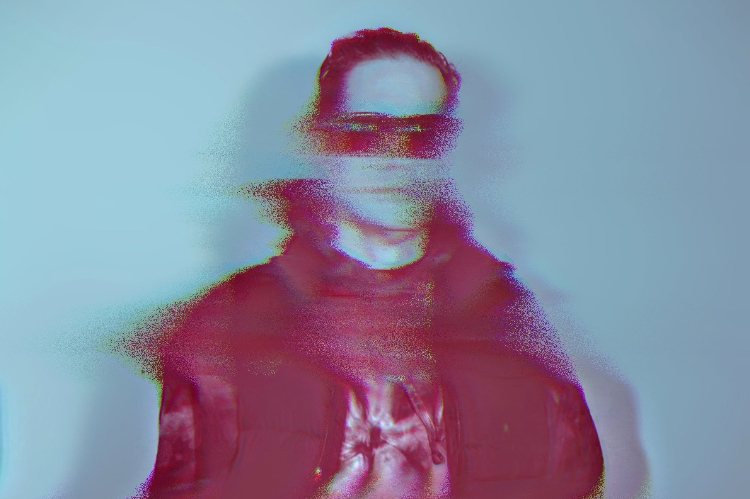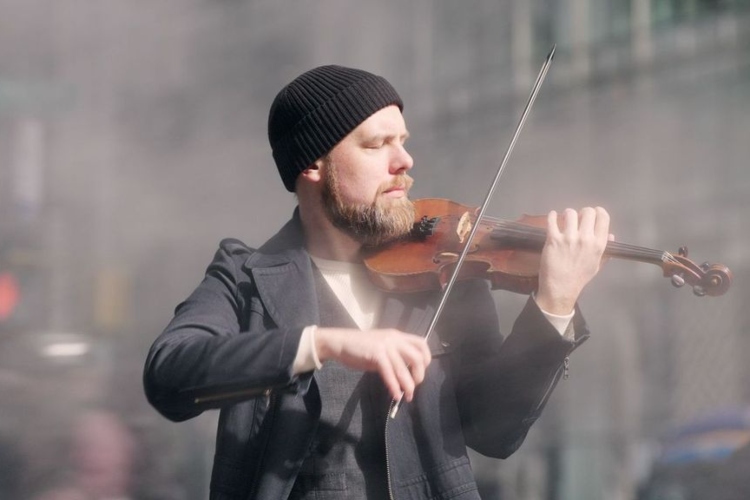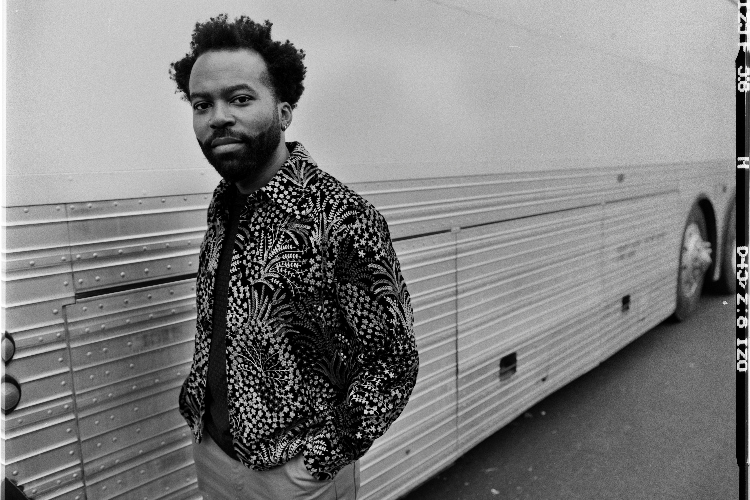Pushing Off: A Conversation with Christopher Hoffman on ‘Vision is the Identity’
|
Getting your Trinity Audio player ready...
|
Henry David Thoreau once noted, “The perception of beauty is a moral test.” Regardless of whether we wish to acknowledge it, one cannot deny that their biases and history shape how they experience everything around them, including art. Interestingly, this artistic predisposition extends to ideas of how a particular instrument “should sound.” In the case of the cello, one often expects polite elegance. But the instrument, in the right hands, is capable of much more. On the ironically titled Vision is the Identity (Out of Your Head, 2024), Christopher Hoffman attempts to obliterate misconceptions about the capacity of the violoncello.
Hoffman comes from a generation of cellists who fully appreciate their instrument’s Western classical tradition yet refuse to be confined to chamber or orchestral settings. In Hoffman’s case, he often uses effects that make his strings sound more like a guitar or bass. Actually, between the edgy individualism apparent in each track and the grim reaper imagery on its cover, a casual listener may think they found a new punk rock album. But this perspective is also inadequate. With “What Comes”, Hoffman mimics the sinuous cry of a steel guitar, thereby placing the legendary Henry Threadgill in an unexpected meeting of Americana and sampled beats. “Better & Better” with Anna Webber on flute burns at a dizzyingly high speed, while “Think From”‘s use of eerie-sounding keys evokes a haunting chorus. Ultimately, what makes Vision is the Identity such a compelling listen is that it is never predictable.
After experiencing Vision is the Identity, one can see why Hoffman has been called upon by some of the most important artists in creative music. Threadgill, Butch Morris, Marc Ribot, James Brandon Lewis, and Yoko Ono have all relied upon Hoffman’s cello to make their artistic dreams a reality. Vision is the Identity is a masterful reminder that you cannot rely solely on what you see. Sometimes, your ears can tell you much more than your eyes ever could.
PostGenre: Going back to the beginning, when did you start playing cello?
Christopher Hoffman: I started playing cello when I was five. My parents put me in a Suzuki program. My dad was a jazz drummer. As was my older brother Bill. So, I got obsessed with playing drums in middle school. Playing drums helped with my cello playing. But I got back into wanting to focus on the cello instead of drums because I realized I was better at the cello.
PG: At what point did you decide that you did not want to play solely stereotypical Western classical music, the music most people identify with the cello?
CH: Somewhere in high school, I discovered Oscar Pettiford.
Growing up and doing the Suzuki stuff, there were kids around me who were savants. Really talented people. I wasn’t playing concertos with the local symphony in middle or high school like they were. So, I was already out of that competitive kind of classical world. It gave me so much anxiety.
I did the normal concerto stuff in college, and it was good for my playing. But even then, I knew it wasn’t what I wanted to do. I didn’t want to play in an orchestra; to work nonstop and hopefully get into an orchestra. I was also interested in many different kinds of music and felt that if I started going in another direction, I could get more into the other stuff I found interesting.
PG: So, does it bother you if any of your work gets classified as classical music? For instance, the New York Times named Henry Threadgill’s The Other One (Pi, 2023), a recording you are on, as one of the best classical albums of 2023.
CH: No, I don’t care. Genres are so weird. Henry would say the same thing as well. Genres are marketing and writing concepts, not musical ones. Though I get it in terms of promoting my new record. I’m not always doing myself a whole lot of favors by falling in between cracks of certain genres.
PG: Why?
CH: Because I want to connect with the audience. Is this record electronic? Maybe. It’s interesting because right now, I’m involved in trying to submit stuff to streaming services for playlists. People have told me, “Oh, I love the new direction you are going in with the single with Anna [Webber].” They either like the beats or the flute soloing. They seem to compartmentalize those things in terms of genre classifications. But you also have to add to it the lineage of jazz cellists, back to Oscar Pettiford. People seem to struggle to process all of those elements together. I can understand that.
PG: “Better & Better” is the track with Anna Webber. On it, at one point, you simultaneously use three time signatures. Was that aspect of the piece something you had planned since the beginning?
CH: Oh, that happened by accident. There is a normal groove in seven, the drums are playing four, and it features a bridge in thirteen. At some point, all three parts are happening at the end but the combination of those time signatures wasn’t something I had planned out. It just came from putting together these different parts that I thought would work well together. It wasn’t from an exercise or something I was trying to figure out. It just ended up working.
PG: A minute ago, you mentioned Oscar Pettiford. Initially musicians playing improvised cello were, like Pettiford, originally or primarily bass players. They were not first and foremost cello players. Today, many improvisers play cello as their primary instrument. What do you think changed in terms of presenting the cello?
CH: Yeah, it’s interesting. You’re right. There are so many early pizzicato improvising cello records. Ron Carter may have been one of the only people improvising arco when he made his album, Where? (New Jazz, 1961). He also did it on an Eric Dolphy album.
PG: Out There (New Jazz, 1961)?
CH: Yeah, that’s the one, exactly. Then, of course, there is Dave Holland’s solo cello record [Lifecycle (ECM, 1982)] . And from there, there is a little more arcoing happening.
For me, it was Erik Friedlander when I saw him play at Appleton Lawrence Conservatory in Appleton, Wisconsin. His performance there unlocked a lot of things for me. I contacted him afterward via email, and he started collecting, he had it on his website at one point, a cello and jazz discography. He was documenting everything. Erik told me I should check out Hank Roberts, and I got very deep into Hank’s music. Obviously, Erik himself has also done quite a bit. And, of course, I need to mention Abdul [Wadud] as well.
But, you’re right. Starting in the 2000s, you see a lot of improvising cellists – Okkyung Lee, Tomeka Reid, and Rubin Kodheli, to name a few. Now, there are so many of us. I’m sure there are a bunch of jazz cellists out there that I don’t even know about.
PG: One thing that sets your cello performance apart from many others in the tradition is your use of effects. Sometimes you sound more like a traditional cello. At other times, you sound more like a guitar or bass. What do you enjoy most about manipulating and changing the instrument’s sound through effects?
CH: Well, I think one of the great things about the cello is it allows you to play it in several different ranges that could mimic other instruments. I love shredding electric guitar playing, and with the right combination of things, I can get that sound. I also love bass, so sometimes I make the cello sound like a bass. My instrument has a lot to offer in terms of shredding and bass playing. It’s great getting to explore all of it.
PG: You can hear the diversity of those sounds well on Vision is the Identity. Getting into the album, where did its title come from?
CH: I don’t know. It’s one of those titles where you understand it in your own way. But everything is so much about what people see; their outer vision. But I’m looking more at inner vision in terms of the title.
PG: The album’s cover art is, like with Asp Nimbus, very striking. Both adopt a punk rock mentality in their presentation.
CH: Yeah. The artwork for the last two records is by T.J. Huff. For Asp Nimbus, I knew I wanted a rendering of the death of Cleopatra, and that’s all I talked to him about. He then did this woodcut with the snake and the huge boobs and everything. I did not expect that version, but it was great.
When it came to Vision is the Identity, I had an idea of the Grim Reaper looking at himself in the mirror. I’d been looking at many 80s comic books, like Creepshow, and wanted art in that vein. I find it very visually interesting. And it also had a kind of a Bones Brigade vibe to it too. Maybe there was some late 90s influence deeply buried in my subconscious too.
PG: The cover also fits the eccentricity captured with the first track, “Cloud Buster.” You named that piece after a device created by Austrian psychoanalyst Wilhelm Reich that was designed to control the weather. What inspired you to use this reference for the piece?
CH: Actually, that’s the one track on the record that I wrote years before we were putting the album together. Everything else I wrote during the pandemic. But I knew that “Cloudbuster” would work well with the other stuff I had done for the record.
When I title a track, I like to use something interesting but a bit esoteric. I like the idea of people having to look up what the name is all about. It gives them something to learn about. I always loved doing that with other people’s albums. Wilhelm Reich is an interesting character. The Cloudbuster was just a side project for him. He had this whole encampment. He wrote several influential books on psychoanalysis. And he ended up dying in prison for selling “sex boxes” that he claimed could cure cancer. He lived an interesting life.
PG: You typically start with the piano when composing, correct?
CH: Yeah, I usually sit at the piano to write. I write most of my compositions at the piano in terms of harmony. I figure out what the harmony will be and then go from there in terms of how rhythmically fast it should move and what other lines will work with it.
PG: However, with “Cloudbuster,” you did not start with the piano?
CH: Right. With “Cloudbuster”, I wrote the bass line first then wrote stuff around it. But I think everything else on the album I composed using my usual approach of sitting at the piano. At least to figure out the composition’s harmony and how to move it around.
One thing that makes this album different from others I’ve done is that, here, I did not have an ensemble in mind when I started writing. With most records, I usually have an ensemble in mind before I even start writing. But I did not do that here. Instead, I was writing during the pandemic and pulled my ideas into Pro Tools. Then, I started doing drum sequencing and programming. I played it for Bill Campbell while we were working on another project. We started talking about records with both drum machines and live drummers. And that’s where we started focusing and went from there. You can hear the interplay between my programming and Bill’s drums especially well on “What Comes.”
PG: You also feature Henry Threadgill on “What Comes.” You have worked with Threadgill for several years in Zooid. How did you first get hooked up with him?
CH: Back in 2007 or 2008, he called me for a gig he was playing at the [Museum of Modern Art in New York]. The gig was three cellos plus Jose Davila [on tuba] and Elliott [Humberto Kavee] on drums. I think Erik Friedlander recommended me to Henry. I did that one gig and it was incredibly intense. It was amazing, but also was very intense.
Then I didn’t hear from Henry for a couple of years until one day he called me up and was like, “Hey, Chris, are you still playing the cello?” I told him I was, and he asked me to rehearse with him. And that was the beginning of my working with Zooid.
PG: What do you feel you have learned the most from working with Threadgill?
CH: Wow, the most. I mean, even within the small group of Zooid, the way he orchestrates the range of different instruments to combine their timbres is so big. His rhythmic concept is also very big. I’ve learned a lot of things from him.
I also learned that I couldn’t just plug in all my scale shit into his system. That completely changed my playing, in a great way. It was a little frustrating at first, but it opened up things I can now use with more traditional harmonies. That was big for me.
PG: To ask you a bit of a random question, you are also a filmmaker, correct?
CH: Yeah, in the last couple of years, I’ve been shooting a bunch of music videos and did a short film.
PG: Do you see a connection between your work as a director and that as a musician?
CH: Well, as long as I’ve been making records, people have called my music cinematic. I have always loved film, and my dad loved film. Frankly, I didn’t get into filmmaking earlier because I mislabeled it as a rich kid’s hobby just because of how expensive it is to make something. My brother and I wrote a screenplay in the early 2000s that ended up at an agency for a second. We were very excited and thought something might happen. But the agency told me I first needed to make a short film and show what I could do as a director. I didn’t have the resources to do that and was busy raising my kid anyway.
But as you get older, things change a lot in your perspective. They also change a lot in terms of technology. You can easily buy a camera that will allow you to make a short film without spending a ton of money. As those things opened up and I got older, I got into directing. Sometimes it’s nice to have something other than music and to alternate between the two. If I’m working on a record, when I get burned out on that, I can just jump to a film project. It’s another thing to be able to do. It’s another bonsai tree to be trimming all the time.
PG: Going back to your comments on the history of the cello and even Cleopatra, as a final question, what are your thoughts on the role of tradition and history? You are in James Brandon Lewis’ Red Lily Quintet, which draws inspiration from historical figures. But you are also approaching the cello in an nontraditional way.
CH: I don’t think about it too much. All the people I looked up to were always pushing boundaries. The whole idea of avant-garde music is to push beyond restrictions.
And in terms of tradition, I don’t know. I went through a whole period in college where I played standards and loved doing that. If anything, I find the cello a little frustrating to try and play in the tradition. There aren’t many arco swinging string players to begin with, and when there are, what they do is very specific.
Miles Davis was huge for me as a kid. My dad had his autobiography. I remember reading it during my freshman year in high school. I already knew some of Miles’ music then, but the book opened up a bunch of stuff for me. Whether he was working with [John] Coltrane, Wayne [Shorter], or anyone else, Miles was always pushing off of what came before. I try to follow that example.
‘Vision is the Identity’ will be released on Out of Your Head Records on March 22, 2024 It is available for pre-order on Bandcamp. There will also be a live listening party of the album on Bandcamp on March 19, 2024. You can register here. More information on Christopher Hoffman can be found on his website.



